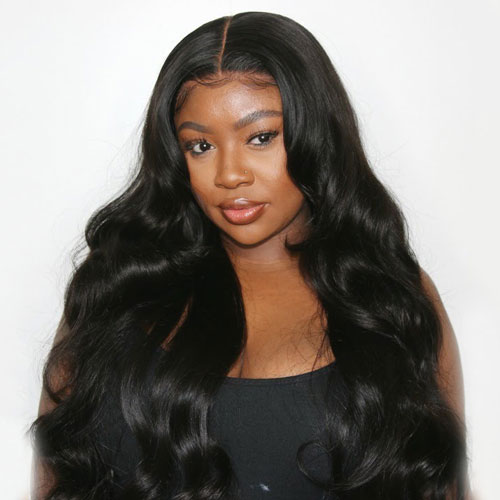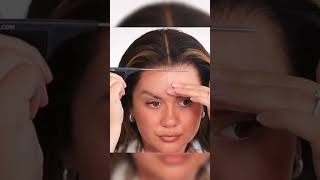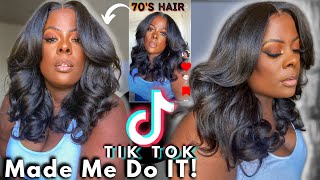Low Density Vs. High Density Wig, Which One Better
- Posted on 12 May, 2023
- Lace Front Wig
- By yyl
Wigs have been a popular choice for people who want to enhance their beauty or need to cover up hair loss due to various medical conditions. They come in different densities, and the density of a wig refers to the amount of hair strands used to create the wig. Wig density is an essential factor to consider when purchasing a wig, and choosing between low density and high density can be confusing. These terms refer to the amount of hair per square inch on the wig cap. Low density wigs have less hair, while high density wigs have more hair. But which one is better for you?
Low density wigs.

Low density wigs are wigs that have less hair on the cap, usually between 80% to 130% of the normal hair density. This means that the wig will look thinner and more natural than a high density wig. Low density wigs are ideal for people who want a subtle and realistic look, or who have a small head size.
Some of the benefits of low density wigs are:
– They are lighter and more breathable, which makes them more comfortable to wear, especially in hot weather.
– They are easier to style and manage, as they have less hair to deal with.
– They are more affordable than high density wigs, as they require less material and labor to make.
Some of the drawbacks of low density wigs are:
– They may not provide enough coverage or volume for people who have severe hair loss or bald spots.
– They may not suit people who want a dramatic or glamorous look, or who have a large head size.
– They may not last as long as high density wigs, as they are more prone to shedding and tangling.
High density wigs.

High density wigs are wigs that have more hair on the cap, usually between 150% to 250% of the normal hair density. This means that the wig will look thicker and fuller than a low density wig. High density wigs are ideal for people who want a bold and stunning look, or who have a large head size.
Some of the benefits of high density wigs are:
– They provide more coverage and volume for people who have severe hair loss or bald spots.
– They suit people who want a dramatic or glamorous look, or who have a large head size.
– They last longer than low density wigs, as they are more durable and resistant to shedding and tangling.
Some of the drawbacks of high density wigs are:
– They are heavier and less breathable, which makes them less comfortable to wear, especially in hot weather.
– They are harder to style and manage, as they have more hair to deal with.
– They are more expensive than low density wigs, as they require more material and labor to make.
What are the different between hair densities and their volumes?
Hair density is a measure of how many hairs are on a person’s scalp. Hair volume is a measure of how much space the hair occupies. Different hair densities and volumes can affect the appearance and styling of hair.
There are three main categories of hair density: low, medium, and high. Low-density hair has fewer hairs per square inch than average, and may look thin or sparse. Medium-density hair has an average number of hairs per square inch, and may look normal or balanced. High-density hair has more hairs per square inch than average, and may look thick or full.
Hair volume can vary depending on the texture, curl pattern, and length of the hair. Fine hair has a small diameter and tends to lie flat against the scalp, resulting in low volume. Coarse hair has a large diameter and tends to stand out from the scalp, resulting in high volume. Curly or wavy hair can also create more volume than straight hair, as it forms loops or bends that add dimension. Longer hair can weigh down the volume, while shorter hair can enhance it.
To determine your hair density and volume, you can use some simple methods at home. For hair density, you can count the number of hairs in a one-inch section of your scalp, or compare your scalp visibility to a reference chart. For hair volume, you can measure the circumference of your ponytail, or compare your hair shape to a reference chart.

How to choose between low density and high density wigs?
Choosing between a low density and high density wig depends on your personal preference, hair type, and the look you want to achieve. It depends on your personal preference, budget, lifestyle, and hair condition. Here are some factors to consider when choosing between low density and high density wigs:
– Your head size:
If you have a small head size, you may prefer a low density wig that will not overwhelm your face or make your head look bigger. If you have a large head size, you may prefer a high density wig.
– Your hair loss condition:
If you have mild to moderate hair loss or thinning hair, you may prefer a low density wig that will blend with your natural hair and create a realistic look. If you have severe hair loss or bald spots, you may prefer a high density wig that will provide full coverage and create a voluminous look.
– Your desired style:
If you want a simple and natural look, you may prefer a low density wig that will mimic your own hair texture and movement. If you want a complex and glamorous look, you may prefer a high density wig that will allow you to create various styles and curls.
– Your budget:
If you have a tight budget, you may prefer a low density wig that will cost less than a high density wig. If you have a flexible budget, you may prefer a high density wig that will offer more quality and longevity.
Low density Vs. high density wig: Which one is better?
There is no definitive answer to which one is better between low density and high density wigs. Both types of wigs have their advantages and disadvantages, and it’s essential to understand them to make an informed decision.
For those with thin hair or those who want a natural-looking hairstyle, a low density wig is a better option. Low density wigs offer a more subtle change and are less noticeable. They also provide better ventilation, making them more comfortable to wear in warm weather. However, low density wigs may not be suitable for those with thick hair as they may not offer enough volume.
On the other hand, high-density wigs are ideal for those who want a more voluminous hairstyle or those with thinning hair who want to add more hair. They can hide hair loss more effectively than low density wigs and provide more coverage. However, high-density wigs can be heavier and less breathable, making them uncomfortable to wear in hot weather.
Will high-density wigs change their appearance with varying humidity?
This is a common question among people who wear wigs for cosmetic or medical reasons. The answer depends on the type and quality of the wig, as well as the level of humidity in the environment. Generally speaking, high-density wigs are more resistant to humidity changes than low-density wigs, because they have more hair strands per square inch and less space between them. This means that high-density wigs can retain their shape and volume better than low-density wigs, which may become frizzy or flat in humid conditions. Depending on the type, quality and style of the wig, humidity can cause the following effects:
– The material of the wig:
Synthetic wigs are usually more prone to humidity damage than natural hair wigs, because synthetic fibers can lose their elasticity and texture when exposed to moisture. Natural hair wigs, on the other hand, can absorb some moisture and adapt to the humidity level, but they may also become dry or brittle if the humidity is too low.
– The quality of the wig:
High-quality wigs are usually made with finer and smoother hair strands that are less likely to frizz or tangle in humid conditions. Low-quality wigs may have coarser and rougher hair strands that can easily get frizzy or matted in humidity.
– The style of the wig:
Wigs that have curls, waves, or layers may be more affected by humidity than straight or blunt-cut wigs, because humidity can alter the shape and definition of these styles. Wigs that have bangs or fringes may also be more sensitive to humidity, because these parts of the wig are closer to the forehead and can absorb more sweat and oil from the skin.
How prevent these effects?
To prevent or minimize these effects, it is important to take good care of your high-density wig and protect it from humidity fluctuations. Here are some tips that you can follow:
- – Store your wig in a cool and dry place away from direct sunlight and heat sources.
- – Use a wig stand or a mannequin head to keep your wig in shape when not in use.
- – Avoid wearing your wig in humid environments such as bathrooms, saunas, or rainy days.
- – Use a humidifier or a dehumidifier to control the humidity level in your room or house.
- – Use products that are specially designed for wigs such as shampoos, conditioners, sprays, and serums. These products can help moisturize, nourish, and protect your wig from humidity damage.
- – Avoid using products that contain alcohol, sulfates, or parabens as they can dry out and damage your wig.
- – Use a wide-tooth comb or a wig brush to gently detangle your wig before and after wearing it.
- – Use cold water and mild detergent to wash your wig once every two weeks or as needed.
- – Rinse your wig thoroughly and pat it dry with a towel. Do not wring or twist your wig.
- – Let your wig air dry on a wig stand or a mannequin head. Do not use a blow dryer or expose your wig to direct sunlight or heat sources..
Conclusion.
Low density and high density wigs both have their advantages and disadvantages. The best way to choose between them is to consider your own needs and preferences. You can also consult with a professional wig stylist or seller who can help you find the perfect wig for you. With proper care, your wig can last for years and give you confidence and beauty.
Related Articles
What Is The Best Density For A Wig





